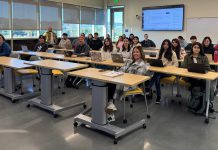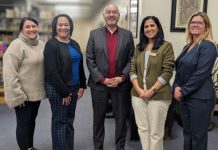Successful social and academic development may depend on whether
or not children attend
Gilroy – Preschool is not just finger-painting and snack time. It teaches children more than just colors and the letters of the alphabet. The impact of attending preschool prepares children both socially and academically for the next 13 years, and may even save the state in future spending.
“Children do learn through play,” said Susan Alonzo, director of Gavilan College’s Child Development Center. “I think there is a big difference when children don’t attend preschool … They do have a bit of catching up to do.”
In May, the Gilroy Unified School District passed a motion to establish an all-day kindergarten program within the next 10 years. Many of the arguments surrounding the board’s decision were the result of trying to get all children meeting state academic standards.
But even entering kindergarten, some children are already behind.
“Our curriculum is based on what children should know when they get to kindergarten,” said Michelle Skogen, director of Countryside Daycare and Preschool in Gilroy.
But aside from learning basic colors, shapes, numbers and letters, preschool teaches children how to interact with one another.
“One of the most important things preschool teaches is how to get along,” Skogen said. “Preschool teaches children how to use their manners, how to state what their needs are and how to stick up for themselves in an appropriate fashion.”
In a study released in March by the Rand Corporation, a non–profit research institution, investments of public money for making preschool available to all 4–year-olds would generate an estimated $2 to $4 for every dollar spent.
That money would offset spending on grade repetition of students and save in special education funding. RAND economists also believe the investment would reduce the crime rate in the future.
In preschool, the simple act of teaching a child how to pour a glass of milk has value.
It teaches them fine motor skills such as spatial recognition and estimating, but they also learn how to do it for themselves, according to Alonzo.
“They may spill it, but they learn how to clean it up,” she said. “They learn consequences.”
According to the RAND study, about 65 percent of California’s 4–year-olds are enrolled in preschool. However, variations occur in enrollment rates based on factors such as race, family income and parents’ education. Hispanic children had the lowest rate of attendance.
Skogen has observed a change in parents’ expectations for their preschool age children : More and more parents are expecting their children to be reading by age two or three, she said.
Those expectations may be the result of changes in state academic standards.
“A lot of times I feel like in kindergarten these days, they expect more of (students) than in the past,” Skogen said.
Alonzo agreed.
“When the kids get to kindergarten there’s so much more expected of them now,” she said.
Gavilan’s CDC preschool program recently earned accreditation from the National Association for the Education of Young Children – the nation’s leading organization of early childhood professionals. It is the only early childhood center in Gilroy to be NAEYC accredited.
There, listening to music is the beginning of language development and playing with blocks teaches children the importance of balance. Water is a source of splashing entertainment, as well as measurement skills.
“(Kids) need to learn those skills in a fun way,” Alonzo said. “Even the stages of coloring (are important.) When they’re drawing with their crayons, they move to pencils and learning to write. Even scribbling is important – they need to get through the scribbling to get to the writing.”
One of the differences Alonzo notices in children who have not attended preschool is in their behavior. For example, sitting for extended periods of time might be difficult for a child who hasn’t been to preschool before, she explained.
Alonzo recommends all children attend some form of preschool – “Even if it’s not a full–time thing,” she said.
Her recommendation has support. Hollywood actor and child advocate Rob Reiner, who helped establish the First Five program in 1998, is pushing for a June 2006 ballot initiative that would offer preschool programs to all California 4–year-olds.
State Superintendent of Public Instruction Jack O’Connell has backed Reiner’s cause, citing the RAND study and reasoning that the program would help close the achievement gap and benefit California economically.
While private preschools may be too expensive for some families to afford, there are other local options available.
In several GUSD elementary schools, there are state-run preschools with Head Start programs, said Yolanda Garcia, director for the Institute for Advancing Excellence in Early Education in San Jose.
Parents can also contact Go Kids, Inc. for referrals to subsidized programs, she said.
“Bottom line, what kindergarten teachers notice is when a child is able to listen to directions, when a child is able to sit and listen and take direction, sit quietly and read or look at pictures and take turns,” Garcia said. “All those are important skills that a kindergarten teacher recognizes immediately – and there is a difference when children do not attend preschool (beforehand).”












